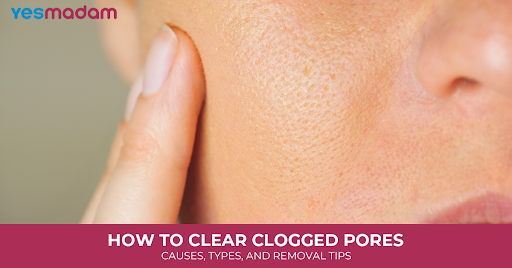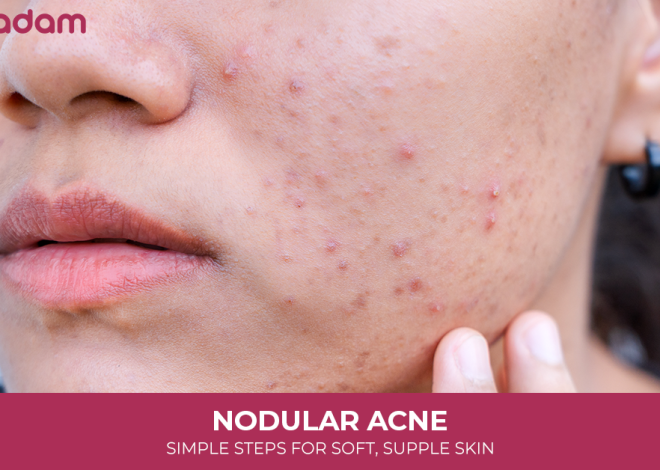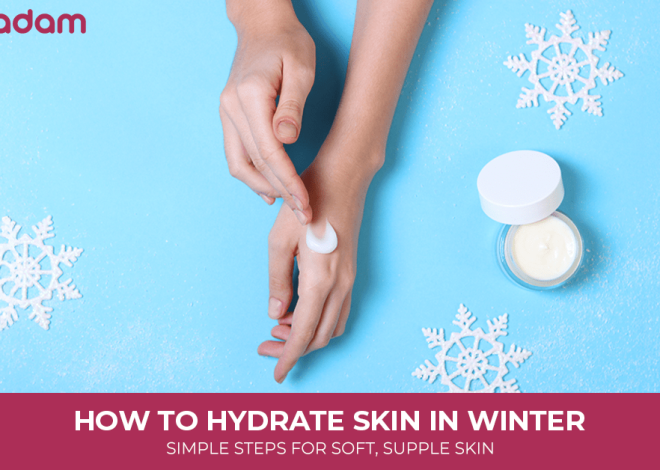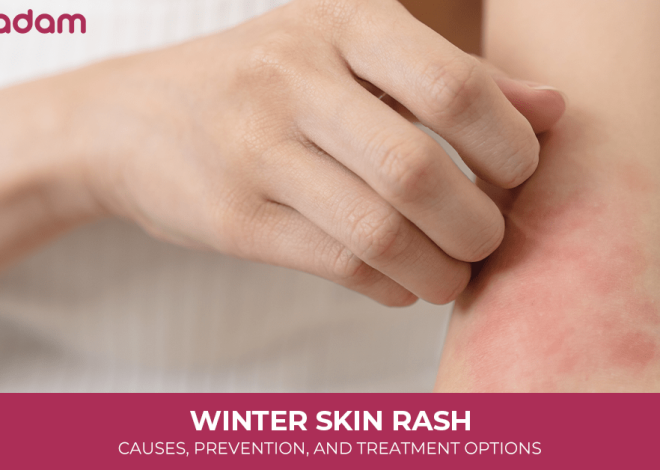
How To Clear Clogged Pores: Causes, Types, and Removal Tips
“Clogged pores” is a skincare issue that people face due to increasing pollution levels, climate change, and other lifestyle factors, including stress.
To prevent them from turning into painful acne, it is essential to treat them beforehand.
When your pores are clogged, skincare products stay on the surface instead of getting absorbed, which leads to further buildup and grime.
This guide on how to clear clogged pores will help explore the meaning of clogged pores, what their causes are, and prevention tips.
Table of Contents
What are Clogged Pores?

Clogged pores, dermatologically known as comedones (blocked hair follicles), occur when dead skin cells, oil, dirt, and bacteria accumulate within the skin’s openings. Build-up of dead skin cells, dirt, oil, and bacteria can lead to clogged pores in your skin. Present on the face, you may notice pores anywhere on your body parts, including the chest, neck, back, scalp, and shoulders.
The primary function of a pore is to transport sebum to the skin’s surface. However, when pollutants and debris mix with this oil inside the pore, it can disrupt skin texture and appearance. If left untreated, clogged pores can potentially lead to acne.
What Causes Clogged Pores?
Before knowing about the tips and tricks on how to remove clogged pores. It is important to unearth the causes first. Excess oil and dead skin cells are the two leading causes of clogged pores. The other main causes include :
- Make-up residue: If left on skin overnight, makeup can get trapped in the skin and lead to clogged pores and breakouts.
- Poor lifestyle habits: Unbalanced diet, along with sleep deprivation, decrease your skin’s resistance to external stimulants, which cause hormonal imbalance and clogged pores.
- Hormonal imbalances may trigger irregular oil production, causing clogged pores.
- Stress may lead to hormonal fluctuation, which leads to clogged pores.
- Excess sebum release on face may form a layer on your skin, clogging your pores.
How to Cure Clogged Pores?

Wondering what to do for clogged pores? Luckily, it is easy to treat and prevent clogged pores via the following easy tips :
Exfoliation
Exfoliating your skin using BHAs or AHAs is the best way of preventing clogged pores. Exfoliation helps remove dead skin and also enhances the skin’s renewal process.
Hydration
Yet another effective clogged pores solution is hydration. Drinking plenty of plain old water also helps improve the health of your pores and skin.
Non-comedogenic products
The word ‘non-comedogenic’ itself implies that the product does not clog pores. Choose cosmetics, cleansers, and moisturizers with a “non-comedogenic“ or oil-free label.
Gentle Cleansing
Apply a gentle non-comedogenic cleanser to prevent clogged pores and warm (hot water) to cleanse your face twice regularly. Follow up with an oil-free moisturizer to prevent dryness in the skin.
Remove makeup thoroughly
At the end of the day, wipe all the makeup off your skin to stop the pores from getting clogged overnight.
Apply sunscreen regularly
Sun damage can also lead to clogged pores. Buy sunscreen with a minimal SPF of 30 and apply it 15 minutes before you go outside.
Extractions
Skin extractions are an important part of a facial treatment wherein a dermatologist applies pressure manually around the clogged pores. This helps extract the blackhead content.
Healthy diet
Consuming processed food may also lead to congested skin. Incorporate a healthy diet including fresh fruits, whole grains, and vegetables for unclogging pores naturally.
Can Moisturiser Clog Pores?

Yes, moisturisers can clog pores, particularly if they contain comedogenic (pore-clogging) ingredients, or if they are too heavy or used in excess. This can lead to breakouts and other skin problems.
Here’s a more detailed explanation:
How Moisturizers Can Clog Pores:
Comedogenic Ingredients: Some moisturisers contain ingredients that are known to clog pores, such as certain oils (like coconut oil or cocoa butter), lanolin, and some synthetic emollients.
Product Formulation: The thickness and texture of a moisturiser can also play a role. Heavy, occlusive moisturizers are more likely to trap oil and debris, leading to clogged pores, especially for those with oily or acne-prone skin.
Amount Used: Applying too much moisturiser, especially if it’s a heavy formula, can overwhelm the skin and contribute to clogged pores.
Skin Type: People with oily or acne-prone skin are more susceptible to clogged pores from moisturisers because their skin naturally produces more oil.
How to Choose a Moisturiser That Won’t Clog Pores:
Look for Non-Comedogenic Formulas: Choose moisturisers labeled as “non-comedogenic” or “oil-free”.
Consider Lightweight, Water-Based Moisturisers: These formulas are less likely to clog pores, especially for oily or combination skin.
Read Ingredient Labels Carefully: Avoid moisturisers with known pore-clogging ingredients, like heavy oils or certain synthetic emollients.
Patch Test: Test new moisturisers on a small area of skin before applying them to your entire face to check for any adverse reactions.
Apply to Damp Skin: Applying moisturiser to damp skin can help it absorb better and prevent it from sitting on top of the skin, potentially clogging pores.
In addition to choosing the right moisturiser, consider these tips:
Exfoliate Regularly: Exfoliating helps remove dead skin cells that can contribute to clogged pores.
Don’t Over-Moisturize: Use only the amount of moisturiser needed to hydrate your skin, and avoid applying excessive amounts.
Cleanse Thoroughly: Always cleanse your skin before applying moisturiser to remove any dirt, oil, or makeup that could contribute to clogged pores.
Types of Clogged Pores and Effective Treatments for Each
The following is a table outlining the types of clogged pores and the best treatments for each :
| Clogged pore type | Description | Common causes | Treatment options |
| Whiteheads | Elevated, white-coloured, fresh lump on the skin. | Improper cleansing, hormonal fluctuations. | Gentle exfoliation, benzoyl peroxide. |
| Blackheads | A hole in your skin filled with a black or dark blue fluid. | Dead skin, excess oil, and environmental pollutants. | Clay masks, retinoids. |
| Pustules | A type of pimple that contains pus. | Acne, bacterial infection. | Benzoyl peroxide, salicylic acid. |
| Papules | Small, red, inflamed bumps without a head. | Irritation from skincare products. | Gentle cleansing, dermatologist advice. |
| Cystic acne | Painful, pus-filled lumps inside the skin. | Genetics, hormonal fluctuations. | Retinoids, dermatologist recommendation. |
More Information For You: Dry Skin Acne
Conclusion
Follow the aforementioned tips on how to clear clogged pores effectively. Clogged pores may also turn into acne if ignored. But the right skincare routine, lifestyle tips can set things right. But if lifestyle and skincare tips are not making any changes, professional treatments like microdermabrasion and chemical peels may help.
Identify what causes your pores and talk with your dermatologist before applying over-the-counter treatments combined with professional procedures to prevent any side effects or adverse reactions.
FAQs
What are the best DIY home remedies for clogged pores?
DIY home remedies for clogged pores include facial steaming, face masks (clay or charcoal), natural exfoliants (like sugar or oatmeal), and gentle cleansers.
How to remove clogged pores on face?
To effectively remove clogged pores on your face, focus on a skincare routine with regular cleansing, exfoliation, and the use of targeted products.
How do I unclog pores in 5 minutes?
To remove pores quickly in 5 minutes. Include a combination of gentle exfoliation and steam. A baking soda paste can help loosen and remove debris, while steaming opens up pores to facilitate easy cleaning.
Does salicylic acid help clear pores?
Yes, salicylic acid can help clear pores. It’s a beta-hydroxy acid (BHA) that exfoliates the skin and penetrates pores to dissolve oil and dead skin cells.
What is the best natural treatment for clogged pores?
Create a homemade scrub with coffee grounds, sugar, or oatmeal to prevent dead skin cells, oil, and debris from settling into pores.
How do I remove clogged pores from my nose naturally?
To remove clogged pores from your nose naturally, apply gentle exfoliation using baking soda or a clay mask.
Does lemon juice help clean pores?
Yes, lemon juice can help clean and reduce the appearance of pores due to its natural astringent and exfoliating qualities.
Does coconut oil clog pores?
Yes, coconut oil is highly comedogenic, which means it may clog pores. It may also actually make acne worse for some people.
What should I eat to unclog pores?
Citrus fruits, berries, papaya, watermelon, and kiwi are the best choices to unclog pores.
Do clogged pores go away naturally?
While clogged pores may eventually go away on their own, they often persist and may need targeted skincare to clear them effectively.



